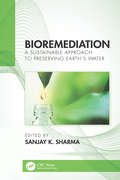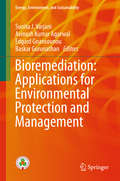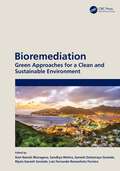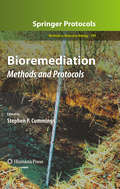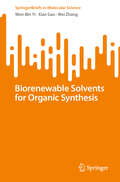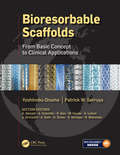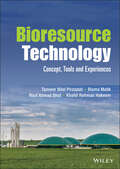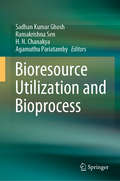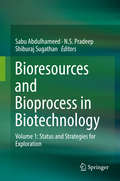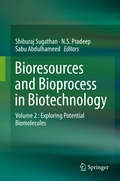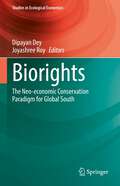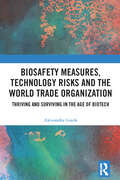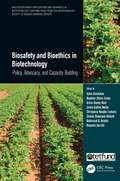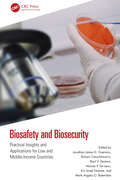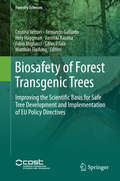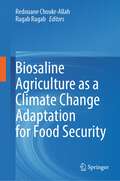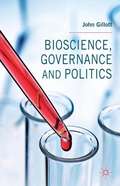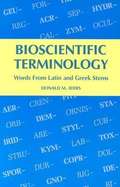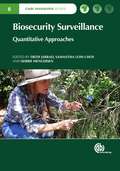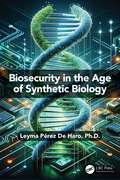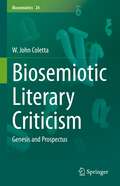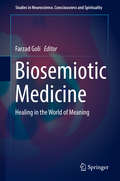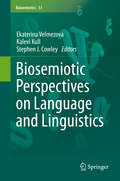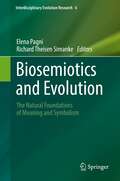- Table View
- List View
Bioremediation: A Sustainable Approach to Preserving Earth’s Water
by Sanjay K. SharmaBioremediation: A Sustainable Approach to Preserving Earth’s Water discusses the latest research in green chemistry practices and principles that are involved in water remediation and the quality improvement of water.The presence of heavy metals, dyes, fluoride, dissolved solids and many other pollutants are responsible for water pollution and poor water quality. The removal of these pollutants in water resources is necessary, yet challenging. Water preservation is of great importance globally and researchers are making significant progress in ensuring this precious commodity is safe and potable. This volume illustrates how bioremediation in particular is a promising green technique globally.Features: Addresses bioremediation of all the major water pollutants Approaches the chemistry of water and the concept of water as a renewable resource from a green chemistry aspect Discusses environmental chemistry and the practice of industrial ecology Explains the global concern of adequate high quality water supplies, and how bioremediation can resolve this Explores sustainable development through green engineering
Bioremediation: Applications For Environmental Protection And Management (Energy, Environment, and Sustainability)
by Avinash Kumar Agarwal Sunita J. Varjani Edgard Gnansounou Baskar GurunathanThis book examines bioremediation technologies as a tool for environmental protection and management. It provides global perspectives on recent advances in the bioremediation of various environmental pollutants. Topics covered include comparative analysis of bio-gas electrification from anaerobic digesters, mathematical modeling in bioremediation, the evaluation of next-generation sequencing technologies for environmental monitoring in wastewater abatement; and the impact of diverse wastewater remediation techniques such as the use of nanofibers, microbes and genetically modified organisms; bioelectrochemical treatment; phytoremediation; and biosorption strategies. The book is targeted at scientists and researchers working in the field of bioremediation.
Bioremediation: Green Approaches for a Clean and Sustainable Environment
by Ram Naresh BharagavaEnvironmental sustainability with rapid industrialization is one of the current major global challenges. Industries are the key drivers of the world economy. But they are also the major polluters of the environment due to the discharge of partially treated/untreated toxic and hazardous wastes containing organic and inorganic pollutants, which cause severe environmental (soil and water) pollution and toxic effects in living beings. So the adequate treatment of industrial wastes to degrade/detoxify pollutants is of the utmost importance for environmental safety and for promoting the sustainable development of our society with low environmental impacts. Bioremediation: Green Approaches for a Clean and Sustainable Environment showcases the latest information on the different bioremediation approaches used for the many types of industrial pollutants and are dedicated to environmental safety. This book provides a detailed knowledge about the natural as well as anthropogenic sources of different types of toxic pollutants, such as toxic metals, dyes, pesticides, petroleum hydrocarbons and plastics; their fate and transport into the environment; their ecotoxicological effects and health hazards; and different approaches used for their bioremediation for the environmental clean-up. Key Features: Covers the different aspects of environmental problems and their remedies with up-to-date developments in the field of bioremediation of industrial/environmental pollutants Serves as an invaluable source of knowledge for a wide range of students, scientists, and researchers in microbiology, biotechnology, environmental sciences with the fundamental and advanced knowledge about the environmental pollution, challenges, and bioremediation of toxic pollutants
Bioremediation: Methods and Protocols (Methods in Molecular Biology #599)
by Stephen P. CummingsSince its first systematic application during the 1970s, bioremediation, or the exploitation of a biological system's degradative potential to combat toxic pollutants such as heavy metals, polyaromatic hydrocarbons (PAH), cyanides, and radioactive material, has proven itself over time, and the many advances in molecular techniques have only amplified its utility. In Bioremediation: Methods and Protocols, experts in the field explore imaginative and ambitious multidisciplinary techniques that will enable more predictable removal of pollutants from a variety of environments. The easy-to-follow volume addresses some of the broader issues such as the effect of the environment in determining the availability and fate of organic and inorganic compounds and how choices around the most appropriate bioremediation process can be arrived at, as well as detailed complementary techniques that support the effective deployment and monitoring of a bioremediation approach. Written in the highly successful Methods in Molecular BiologyTM series format, chapters include introductions to their respective topics, lists of the necessary materials and reagents, step-by-step, readily reproducible protocols, and notes on troubleshooting and avoiding known pitfalls. Authoritative and cutting-edge, Bioremediation: Methods and Protocols offers researchers a series of invaluable techniques certain to enhance their work with environmental contamination.
Biorenewable Solvents for Organic Synthesis (SpringerBriefs in Molecular Science)
by Wei Zhang Wen-Bin Yi Xiao GaoIn this brief the authors introduce a series of recently developed bio-based solvents including cyclopentyl methyl ether (CPME), γ-valerolactone (GVL), 2-methyl tetrahydrofuran (2-MeTHF), propylene carbonate (PC), and cyrene. Traditional organic solvents used for organic synthesis (such as benzene, ether, chloroform) have a series drawbacks on toxicity, environmental impact, and safely related issues. In addition, the fossil fuel-derived organic solvents are not sustainable. Therefore the development of biorenewable solvents is a topic of current interest. For each of the solvents, their production, toxicity profile, renewable pathway, and their utility in organic synthesis, biosynthesis, and separation processes is discussed. The target audiences of this book are organic and medicinal chemists with interests in using green solvents. It can also be used as a reference for undergraduate and graduate courses related to organic and green chemistry.
Bioresorbable Scaffolds: From Basic Concept to Clinical Applications
by Yoshinobu Onuma Patrick W.J.C. SerruysThis book focuses on the coronary bioresorbable scaffold, a new interventional treatment for coronary artery disease, differentiated from a permanent metallic stent. The book provides an overview of the technology including non-clinical studies and clinical evidences in order to help clinicians understand the appropriate application of the technology and the optimal techniques of implantation. It covers the basics of bioresorbable scaffolds; bench test results; preclinical studies; clinical evidences; and tips and tricks of implantation.
Bioresource Technology: Concept, Tools and Experiences
by Rouf Ahmad Bhat Khalid Rehman Hakeem Tanveer Bilal Pirzadah Bisma MalikBioresource Technology Discover the latest developments in the field of bioresource technology with this practical handbook The management and cultivation of bioresources are critical components of the economic survival of nations. Significantly underexplored, recent advances in bioresource technologies have breathed new life into the research and development of new bioresource techniques and capabilities. In Bioresource Technology: Concept, Tools, and Experiences, a team of distinguished researchers delivers a comprehensive work intended to bridge the gap between field-oriented taxonomists and ecologists and lab-oriented functional and molecular biologists. The book is divided into three sections: food, environment, and energy. In the first part, the authors explore the functional food sector, from green and smart food packaging to nanosensors as diagnostic tools in the food industry. The second part is concerned with the achievement of future energy security through the use of bioresources as energy sources. Finally, the third section discusses sustainable environmental management policies via bioresource use. Readers will also benefit from the inclusion of: A thorough introduction on the recent advances in the technology pertaining to functional food industry to overcome the future food challenges Comprehensive explorations of the art and science of growing microgreens, including their historical background, cultivation practices, quality, and shelf life In-depth examinations of the bioprospecting of bioresources, including bioprospecting in agriculture, chemical industries, and diagnostic applications Provides state-of-the art technologies in the green energy sector to cater for the energy demand of the people, reducing greenhouse gases (GHG) and the reliance on fossil fuels In-depth understanding on the recent advances in the bioresource management policies and sustainable environment Perfect for postgraduate students, research scholars, faculty, and scientists involved in agriculture, plant sciences, environmental sciences, bioenergy, biofuels, molecular biology, and microbiology, Bioresource Technology: Concept, Tools, and Experiences is also an indispensable resource for those working in biochemistry, biotechnology, and food technology.
Bioresource Utilization and Bioprocess
by Sadhan Kumar Ghosh Agamuthu Pariatamby Ramakrishna Sen H. N. ChanakyaThis book focuses on the utilization of bio-resources and their conversion pathways for a sustainable future. Tapping into bio-resources by means of thermochemical and biochemical processes has attracted researchers from all over the world; it is a broad area that has given birth to concepts like the biorefinery, as well as a new stream known as biotechnology. Its scope includes biochemical and microbiological engineering, biocatalysis and biotransformation, biosynthesis and metabolic engineering, bioprocess and biosystem engineering, bioenergy and biorefineries, cell culture and biomedical engineering, food, agricultural and marine biotechnology, bioseparation and biopurification engineering, bioremediation and environmental biotechnology, etc. The book discusses a host of new technologies now being used to tap these resources with innovative bioprocesses. All chapters are based on outstanding research papers selected for and presented at the IconSWM 2018 conference.
Bioresources and Bioprocess in Biotechnology
by Sabu Abdulhameed N. S. Pradeep Shiburaj SugathanThis book is a compilation of articles on various aspects of bioresources and the processes employed for its judicious utilization. Biodiversity and conservation, food security, gene banks and repositories, laws governing biodiversity, bioprospecting, bioresources in traditional medicine and biodiversity mining are some of the important topics covered in the book. The unique contents of the book make it an important source of information for conservation scientists, academics, activists and to those who are actively involved in product oriented research from bioresources.
Bioresources and Bioprocess in Biotechnology
by Sabu Abdulhameed N. S. Pradeep Shiburaj SugathanThis book is a compilation of detailed articles on various products and services that can be derived from bioresources through bioprocess. It offers in-depth discussions and case studies on commercially and therapeutically important enzymes, antimicrobials, anti-cancer molecules and anti-inflammatory substances. It also includes a separate section on emerging trends in bioactive substances research. This unique book is a valuable source of information for biotechnologists and bioprocess experts as well as academics and researchers who are actively involved in product and process development.
Biorights: The Neo-economic Conservation Paradigm for Global South (Studies in Ecological Economics #7)
by Joyashree Roy Dipayan DeyThis book evaluates local conservation successes of global south in the climate milieu, as an empirical evidence of ‘Bio-rights’ of commons at community-ecosystem interface for sustainable intensification of nature’s goods and services. Bio-rights is a right-based neo-economic conservation paradigm that compensates the opportunity costs incurred in conservation efforts by the marginal communities, living near globally important ecosystems and dependent on it for their livelihood, through payments from environment services. The book would bring forth the true value of circular economic interventions in socio-ecological conservation, shaped through sustainable human interactions with nature. This multilevel study of conservation science serves an interdisciplinary academia, consistent with conventions on climate change, bio-diversity and sustainable development, to establish links between conservation priorities and development objectives. Herein, Bio-rights is introduced as a ‘design approach’ for production linked sustainable development, supplemented with case studies from the east.
Biosafety Measures, Technology Risks and the World Trade Organization: Thriving and Surviving in the Age of Biotech
by Alessandra GuidaThis book examines the work of the World Trade Organization (WTO), with a focus on the capacity of its judiciary to strike a reasoned balance between free trade in biotechnology and biosafety as to promote the 2030 Agenda for Sustainable Development and its Sustainable Development Goals. By adopting an innovative interpretation of the precautionary principle and proportionality analysis, the work offers normative suggestions to develop what the author terms “a constructive bridge of knowledge” between decision-makers, scientists, social experts and expert witnesses, which can support a judicial balance by design rather than by chance. Biotechnology is sometimes regarded as a panacea for modern-day challenges, such as feeding a growing world population and counteracting climate-change problems, and a means of offering significant economic opportunities. However, biotechnology can present uncertain, though serious, risks to human health and the environment (i.e., biosafety). Trading biotech products magnifies these risks and benefits globally. This book explores the topical, though still underexplored, question of how to find a point of equilibrium between the revolutionary advancement offered by technology and the need to safeguard biosafety from uncertain, though potentially irreversible, technology risks. It offers a thorough analysis of normative, judicial and epistemic issues hindering a reasoned balance between trade and non-trade interests under the WTO. The work offers practical relevance for the resolution of legal disputes in contexts of uncertainty, as well as innovative theoretical contributions. It will be a valuable resource for policymakers working on precautionary governance and management, scholars in the areas of trade law, human rights law and environmental law, law students and practitioners, as well as NGOs working in the field of new technologies, biosafety, sustainability and food safety.
Biosafety and Bioethics in Biotechnology: Policy, Advocacy, and Capacity Building (Multidisciplinary Applications and Advances in Biotechnology)
by Sylvia UzochukwuThis book covers a range of important topics in biotechnology policy, advocacy and education, bioethics, biosafety regulations for genetically modified organisms and gene-edited products and biotechnology manpower development. Throughout the book, the contributors review biosafety and bioethical guidelines that could enhance adoption of biotechnology in alignment with national priorities and research agendas. They also discuss the importance of current biotechnology policy advocacy, enlightenment and public engagement with stakeholders and policy makers. The book will be useful reference material for scientists and researchers working in the fields of food and agricultural biotechnology, biopharmaceuticals and medical biotechnology, environmental biotechnology, biotechnology policy and advocacy, biotechnology communication and manpower development, biosafety and bioethics, etc. Emphasizes recent advances in biotechnology that could ameliorate the high-level global food insecurity through the deployment of the technology in Nigeria Provides detailed information on how to domesticate biotechnology and boost training of the biotechnology workforce in the universities and research institutes Introduces new frontiers in the area of organizing informal biotechnology capacity building courses and professional certification Reviews biosafety and bioethical guidelines that could enhance adoption of biotechnology in alignment with national priorities and research agendas Discusses current biotechnology policy advocacy, enlightenment and public engagement with stakeholders and policy makers Sylvia Uzochukwu, Ph.D., is a Professor of Food Science and Biotechnology, and Director, Biotechnology Centre, Federal University, Oye-Ekiti, Nigeria. Arinze Stanley Okoli, Ph.D., is an Associate Professor at Genoek – Centre for Biosafety, Universitetet II, Breivika, Tromsoe, Norway. Nwadiuto (Diuoto) Esiobu, Ph.D., is a Professor of Microbiology and Biotechnology at Florida Atlantic University, Boca Raton, FL, USA, and the President and Founder of Applied Biotech, Inc. and ABINL. Emeka Godfrey Nwoba, Ph.D., is currently at the Algae Research & Development Centre, Murdoch University, Western Australia. Christpeace Nwagbo Ezebuiro, Ph.D., is a Project Manager, Renewable Energy Expert and Head of Clean Technology Division at the National Biotechnology Development Agency, Abuja, Nigeria. Charles Oluwaseun Adetunji, Ph.D., is an Associate Professor of Microbiology and Biotechnology and the Director of Intellectual Property and Technology Transfer, Edo State University Uzairue, Nigeria. Abdulrazak B. Ibrahim, Ph.D., is a Capacity Development Expert at the Forum for Agricultural Research in Africa (FARA) and Associate Professor of Biochemistry, Ahmadu Bello University, Zaria, Nigeria. Benjamin Ewa Ubi, Ph.D., is a Professor of Plant Breeding and Biotechnology and Director, Biotechnology Research and Development Centre, Ebonyi State University Abakaliki, Nigeria.
Biosafety and Biosecurity: Practical Insights and Applications for Low and Middle-Income Countries
by Jonathan Jaime G. Guerrero, Rohani Cena-Navarro, Raul V. Destura, Marian P. De Leon, Kin Israel R. Notarte, and Mark Angelo O. BalendresThere are many guidelines, protocols and advisories that outline how biosafety and biosecurity can be adopted by institutions around the world. Whilst helpful, many of these are tailored to affluent Western nations. This leaves developing nations far behind since their laboratories and institutions are resource-scarce and biosafety and biosecurity are not mainstreamed entirely among the different laboratory workers, healthcare professionals, researchers, and academics. Biosafety and Biosecurity: Practical Insights and Applications for Low and Middle-Income Countries aims to bridge this gap by comprehensively summarizing the state and development of biosafety and biosecurity in developing and developed nations in a comparative analysis. This book includes basic concepts and principles of biosafety and biosecurity, including certification and legal frameworks, both international and local, and biosafety and biosecurity across disciplines including environmental, medical, and special topics that are relevant to countries with comparable conditions. This proposed book solves the problem of the lack of a prescribed professional title that comprehensively summarizes the state and development of biosafety and biosecurity throughout the world, allowing the reader a 360 view of the subject area.This book will appeal to a global audience of biorisk officers, health and safety professionals and specialists in the life sciences, health and allied fields, environmental science, engineering, and plant and animal agriculture.
Biosafety of Forest Transgenic Trees: Improving the Scientific Basis for Safe Tree Development and Implementation of EU Policy Directives (Forestry Sciences #82)
by Cristina Vettori Fernando Gallardo Hely Häggman Vassiliki Kazana Fabio Migliacci Gilles Pilate Matthias FladungThis book provides up-to-date information on the environmental impact of transgenic trees on genetically modified tree (GMT) communication strategy. It is useful to public/private organisations as well as to private and public research bodies and universities worldwide since it reports on the global status of GMT research and policy. A high number of genetically modified trees (GMTs) with altered or novel characteristics have been produced in the last 15 years. However, their very low public acceptance is a basic problem in their commercialization. Breeders anticipate economic and ecological benefits, like reduced product costs and less pressure on native forests, while opponents fear risks, such as unintended spread of GMTs. But what is true? To answer this question, the COST Action FP0905 focused on key aspects related to GMTs: (a) biological characterization; (b) assessment of possible environmental impacts; (c) socio-economic implications and public acceptance/concerns; (d) providing science-based information to communicate with the public.
Biosaline Agriculture as a Climate Change Adaptation for Food Security
by Ragab Ragab Redouane Choukr-AllahThis book presents recent research work on Biosaline Agriculture presented during First International Forum on Biosaline Agriculture in Laayoune, Morocco from May 3rd to May 4th 2019. The aim of this book is to showcase the global potential of Biosaline agriculture, provide an update on the development of recent innovations in the field of Biosaline agriculture, the best management practices to safely use brackish and saline water, highlight the use of non-conventional water in marginal environment production and the current advanced technologies of desalination of brackish and seawater. The different chapters will also discuss solutions that are adapted to local conditions as part of a sustainable development perspective. The book provides up-to-date technical and scientific data on growing crops under marginal environment so as to encourage the dissemination of this knowledge in the best practices to increase the productivity in Biosaline agriculture, in view of the potential to contribute to food security. The book is expected to stimulate interest in the non-conventional water resources and crops among junior and senior researchers and among those who are increasingly focused on exploiting marginal environments. It will also be of interest to decision-makers and the public and private sectors to jointly address the issues of food security especially of the poor and vulnerable people living in marginal environments worldwide by providing innovative technology transfer.
Bioscience, Governance and Politics
by John GillottThrough case studies, theoretical research and interviews with leading players in science and governance, this book introduces a new understanding of change in governance of bioscience research. In particular it examines change as it is shaped by approaches developed by Science and Technology Studies and Sociology of Scientific Knowledge theorists.
Bioscientific Terminology
by Donald M. AyersLessons that develop a set of guides toward understanding 'new' scientific vocabulary through examination of stems and bases, suffixes etc. A help-yourself guide for 'unlocking' unfamiliar scientific words accompanied by many examples and exercises. -The National Science Teachers Association "This new book is designed to self-teach the budding scientist the basics of the scientific language. " -The Associated Press
Biosecurity Surveillance
by Kerrie Mengersen Sama Low Choy Frith JarradThis book is a source of information on practical and innovative approaches to biosecurity surveillance. It explains the foundation and concepts behind surveillance design, with examples of methods and tools created to deal with surveillance challenges. With supporting case studies and including current directions in research, it covers evidence-based approaches to surveillance, statistics, detectability, single and multi-species detection, risk assessment, diagnostics, data-basing, modelling of invasion and spread, optimisation, and future climate challenges.
Biosecurity Surveillance: Quantitative Approaches (CABI Invasives Series)
by Kerrie Mengersen Frith Jarrad Samantha Low-ChoyThis book provides practical and innovative approaches to biosecurity surveillance. It explains the foundation and concepts behind surveillance design, with examples of methods and tools created to deal with surveillance challenges. With supporting case studies, it covers detectability, single and multi-species detection and risk assessment.
Biosecurity in the Age of Synthetic Biology
by Leyma Pérez De HaroBiosecurity in the Age of Synthetic Biology is a comprehensive review of the biosecurity issues faced by the innovative and rapidly evolving field of synthetic biology. This is a meticulous review of the groundbreaking biotechnological advancements and the critical need for robust biosecurity measures. The book provides an in-depth examination of the ethical, legal, and societal dimensions shaping the future of synthetic biology research, in addition to a practical protocol for biosecurity risk assessment. This is the first book to offer a structured guideline for biosecurity risk assessment in synthetic biology. The author’s balanced view of the opportunities of synthetic biology and the inherent security risks reveals foundational concepts, cutting-edge applications, and international perspectives on biosecurity. This essential guide illuminates scientific and technological frontiers and advocates for a proactive approach ensuring the responsible development and use of synthetic biology. It is an indispensable resource for scientists, policymakers, and anyone interested in the intersection of biotechnology and biosecurity.Key Features: Provides instructions and examples for a biosecurity risk assessment. Includes detailed proposed outline for creating a Biosecurity Manual for broad adoption. Emphasizes the future challenges and opportunities. Offers insights on the role of artificial intelligence in synthetic biology and biosecurity.
Biosemiotic Literary Criticism: Genesis and Prospectus (Biosemiotics #24)
by W. John ColettaThis volume is based to a large extent on the understanding of biosemiotic literary criticism as a semiotic-model-making enterprise. For Jurij Lotman and Thomas A. Sebeok, “nature writing is essentially a model of the relationship between humans and nature” (Timo Maran); biosemiotic literary criticism, itself a form of nature writing and thus itself an ecological-niche-making enterprise, will be considered to be a model of modeling, a model of nature naturing. Modes and models of analysis drawn from Thomas A. Sebeok and Marcel Danesi’s Forms of Meaning: Modeling Systems Theory and Semiotic Analysis as well as from Timo Maran’s work on “modeling the environment in literature,” Edwina Taborsky’s writing on Peircean semiosis, and, of course, Jesper Hoffmeyer’s formative work in biosemiotics are among the most important organizing elements for this volume.
Biosemiotic Medicine: Healing in the World of Meaning (Studies in Neuroscience, Consciousness and Spirituality #5)
by Farzad GoliThis book presents an interpretation of pharmaceutical, surgical and psychotherapeutic interventions based on a univalent metalanguage: biosemiotics. It proposes that a metalanguage for the physical, mental, social, and cultural aspects of health and medicine could bring all parts and aspects of human life together and thus shape a picture of the human being as a whole, made up from the heterogeneous images of the vast variety of sciences and technologies in medicine discourse. The book adopts a biosemiotics clinical model of thinking because, similar to the ancient principle of alchemy, tam ethice quam physice, everything in this model is physical as much as it is mental. Signs in the forms of vibrations, molecules, cells, words, images, reflections and rites conform cultural, mental, physical, and social phenomena. The book decodes healing, dealing with health, illness and therapy by emphasizing the first-person experience as well as objective events. It allows readers to follow the energy-information flows through and between embodied minds and to see how they form physiological functions such as our emotions and narratives.
Biosemiotic Perspectives on Language and Linguistics (Biosemiotics #13)
by Ekaterina Velmezova Kalevi Kull Stephen J. CowleyThe first international volume on the topic of biosemiotics and linguistics. It aims to establish a new relationship between linguistics and biology as based on shared semiotic foundation.
Biosemiotics and Evolution: The Natural Foundations of Meaning and Symbolism (Interdisciplinary Evolution Research #6)
by Elena Pagni Richard Theisen SimankeThis book reviews the evolution of Biosemiotics and gives an outlook on the future of this interdisciplinary new discipline. In this volume, the foundations of symbolism are transformed into a phenomenological, technological, philosophical and psychological discussion enriching the readers’ knowledge of these foundations. It offers the opportunity to rethink the impact that evolution theory and the confirmations about evolution as a historical and natural fact, has had and continues to have today. The book is divided into three parts:Part I Life, Meaning, and InformationPart II Semiosis and EvolutionPart III Physics, medicine, and bioenergetics It starts by laying out a general historical, philosophical, and scientific framework for the collection of studies that will follow. In the following some of the main reference models of evolutionary theories are revisited: Extended Synthesis, Formal Darwinism and Biosemiotics. The authors shed new light on how to rethink the processes underlying the origins and evolution of knowledge, the boundary between teleonomic and teleological paradigms of evolution and their possible integration, the relationship between linguistics and biological sciences, especially with reference to the concept of causality, biological information and the mechanisms of its transmission, the difference between physical and biosemiotic intentionality, as well as an examination of the results offered or deriving from the application in the economics and the engineering of design, of biosemiotic models for the transmission of culture, digitalization and proto-design. This volume is of fundamental scientific and philosophical interest, and seen as a possibility for a dialogue based on theoretical and methodological pluralism. The international nature of the publication, with contributions from all over the world, will allow a further development of academic relations, at the service of the international scientific and humanistic heritage.
